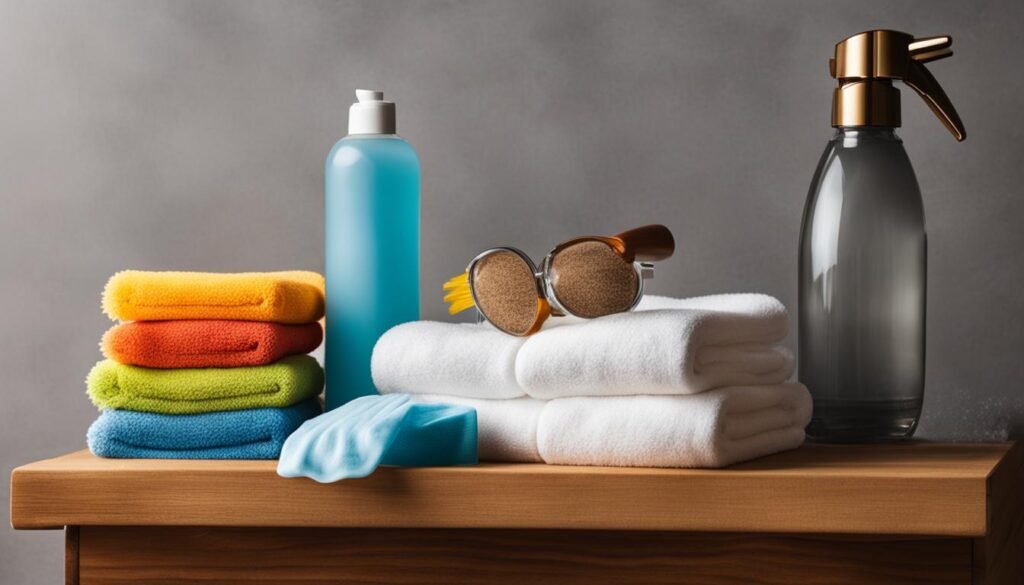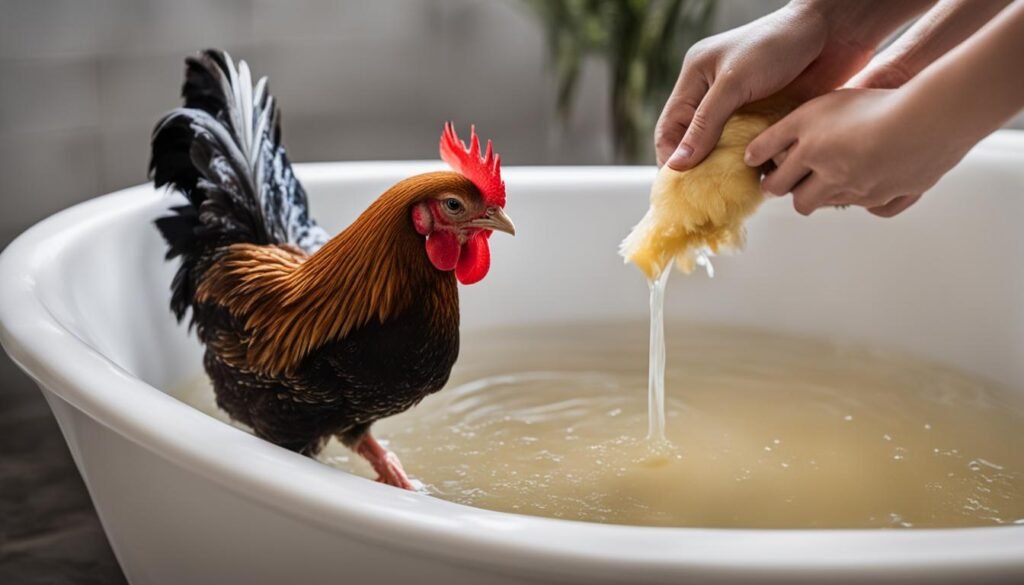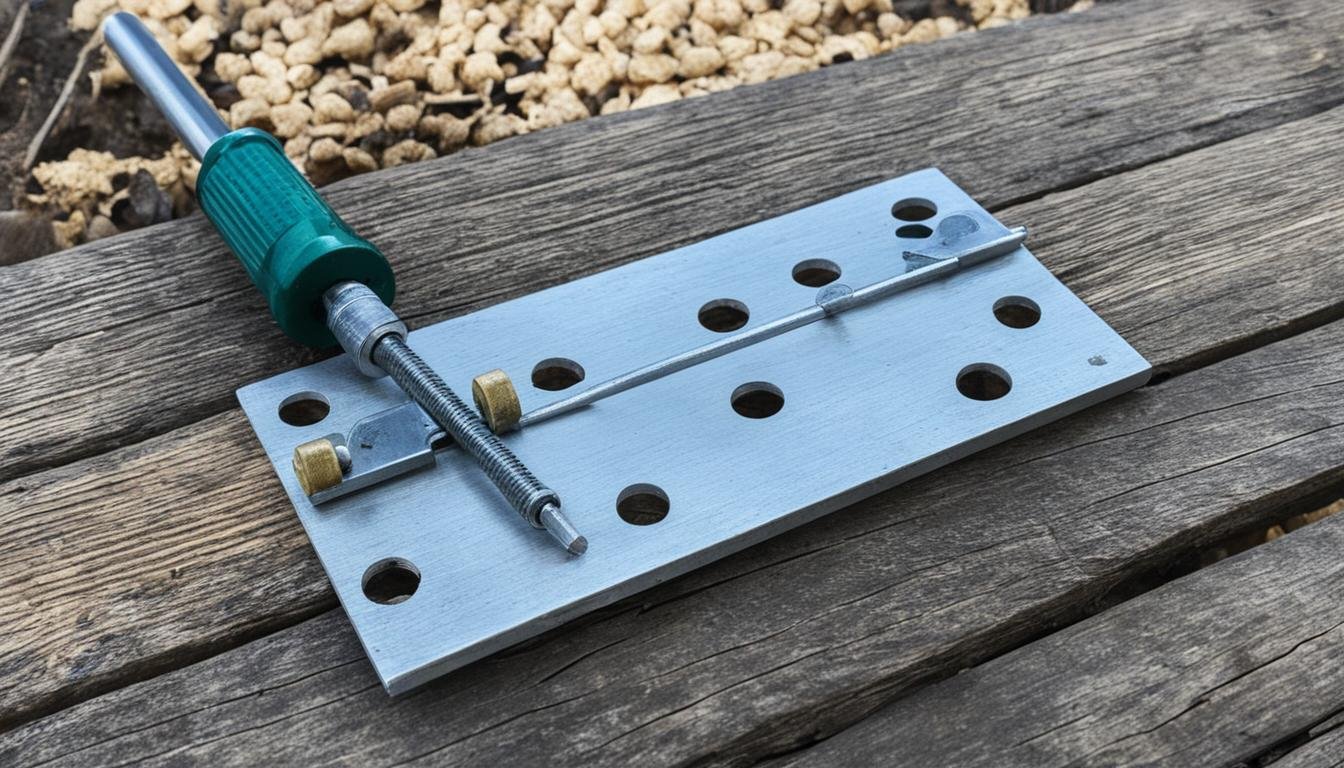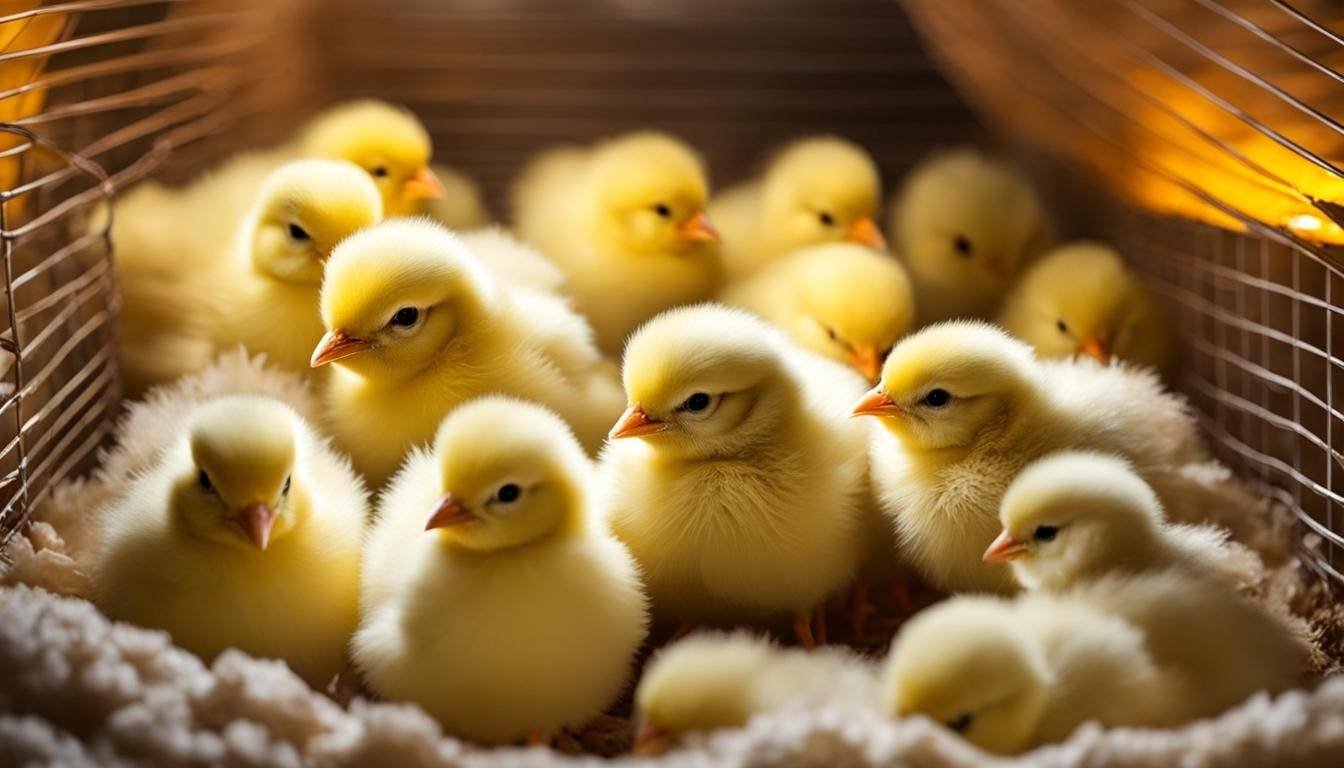Welcome to our gentle guide on how to bathe a chicken safely. While chickens are known for their dust-bathing habits, there are times when a bath becomes necessary. In this section, we will discuss the proper techniques and tips for bathing your feathered friends. Whether you need to clean off droppings or groom your chickens for a show, we’ve got you covered.
When Might a Chicken Need a Bath?
Chickens may need a bath for various reasons. Let’s explore some common situations that may require bathing for your feathered friends.
- Soiling with droppings: Chickens can sometimes get their feathers soiled with droppings, especially if they have been roosting in a dirty area. In such cases, a bath can help remove the stains and keep them clean.
- Flies laying eggs on their skin: Flies may be attracted to soiled feathers and lay eggs on the chicken’s skin. This can lead to further health complications if not addressed promptly. A bath can help remove any eggs and reduce the risk of infestation.
- Sickness or inability to groom: When a chicken is sick or unable to groom themselves properly, their feathers may become unkempt and dirty. Bathing can help freshen them up and improve their overall health.
- Overheating and heat stroke: Chickens exposed to extreme heat may be at risk of overheating and heat stroke. Bathing them with cool water can help lower their body temperature and prevent heat-related illnesses.
Identifying the specific reason for bathing is crucial to provide the appropriate care and treatment for your chicken’s well-being.
| Reasons for Bathing a Chicken | Solutions |
|---|---|
| Soiled feathers | Clean the feathers with a gentle bath using mild pet shampoo. |
| Flies laying eggs | Inspect the chicken’s skin, remove any visible eggs, and bathe with warm water. |
| Sickness or inability to groom | Consult a veterinarian to address the underlying health issue and provide proper care. If necessary, bathe the chicken following the vet’s advice. |
| Overheating and heat stroke | Take immediate action by cooling the chicken with a bath in cool water or placing them in a shaded and well-ventilated area. |
Understanding the reasons for bathing a chicken will help you determine when it’s necessary and how to best handle the situation. In the next section, we will explore the bathing supplies and precautions you should consider for a safe and successful bath.
Bathing Supplies and Precautions
Before bathing a chicken, it’s important to gather the necessary supplies and take certain precautions to ensure their safety and well-being. Here are the chicken bath essentials you’ll need:
- Bathtub or sink: Choose a suitable container to hold the water for the bath.
- Towels: Have soft towels ready for drying the chicken after the bath.
- Rubber shelf liner: Place a rubber shelf liner at the bottom of the container to provide traction and prevent slipping.
- Gloves: Wear gloves to protect your hands and maintain hygiene.
- Pet shampoo: Use a mild pet shampoo specifically formulated for chickens to clean their feathers.
- Nail brush: A nail brush can be handy for gently scrubbing any stubborn dirt or debris from the feet or claws.
When it comes to the safety of your chicken during the bath, keep these chicken bath safety precautions in mind:
- Water temperature: Ensure the water is at a comfortable temperature, neither too hot nor too cold, to prevent distress to the chicken.
- Wing control: Hold the chicken’s wings gently to discourage flapping, which can cause splashing and make the bathing experience stressful for the bird.
- Mild products: Avoid using harsh soaps or vinegar, as they can strip the feathers of natural oils and dry out the chicken’s skin.

| Chicken Bath Essentials | Chicken Bath Safety Precautions |
|---|---|
| Bathtub or sink | Water temperature |
| Towels | Wing control |
| Rubber shelf liner | Mild products |
| Gloves | |
| Pet shampoo | |
| Nail brush |
The Bathing Process Step-by-Step
Bathing a chicken involves a step-by-step process to ensure their cleanliness and well-being. By following these effective chicken bathing methods, you can successfully clean your feathered friend. Let’s dive into the steps:
Step 1: Create a Safe and Comfortable Washing Station
Before you start the bathing process, prepare a suitable washing station for your chicken. Use a bathtub, sink, or large container filled with lukewarm water. Place a rubber shelf liner at the bottom to provide grip and prevent slipping. This will help your chicken feel more secure during the bath.
Step 2: Begin with a Soap Bath
Using a mild pet shampoo, gently lather the chicken’s feathers to remove dirt and soiling. Take care to avoid getting any soap into the eyes, ears, or beak. With your gloves on, massage the soap into the feathers, paying special attention to heavily soiled areas. Rinse thoroughly to ensure all soap residue is removed. This step helps to clean the chicken’s feathers effectively.
Step 3: Follow with a Vinegar-Water Bath
After the soap bath, prepare a vinegar-water solution by mixing one part vinegar with three parts water. This bath helps to remove any leftover soap residue, restores the pH balance of the feathers, and brings out their natural shine. Gently pour the vinegar-water mixture over the chicken’s feathers, making sure to cover the entire body. Take care not to pour the mixture directly onto the chicken’s head or face.
Step 4: Finish with a Plain Water Rinse
Once the vinegar-water bath is complete, give your chicken a final rinse with plain water. This will ensure that all traces of soap and vinegar are removed. Use a gentle stream of water or a container to pour water over the feathers. Be mindful of the chicken’s comfort and avoid splashing water into their face.
Step 5: Gently Handle and Dry the Chicken
Throughout the bathing process, handle the chicken gently to avoid causing any stress or injury. After the final rinse, carefully lift the chicken out of the water and wrap them in a soft towel. Gently press the towel against their feathers to absorb excess water. Avoid vigorous rubbing, as this can damage the feathers. Let the chicken air dry in a warm, draft-free area or use a hairdryer set to the lowest heat and speed setting. Ensure that the chicken is completely dry before returning them to their coop or outdoor area.
Step 6: Repeat as Necessary
Depending on the level of dirt or soiling, you may need to repeat the bathing process. However, it’s important not to overbathe your chicken, as excessive bathing can strip the feathers of their natural oils and lead to dry skin. Monitor your chicken’s cleanliness regularly and bathe them only when necessary.
Now that you are familiar with the step-by-step process, you can confidently clean your chicken using these effective chicken bathing methods. This ensures that your chicken remains healthy, clean, and comfortable.

| Benefits of Step-by-Step Bathing | Precautions to Consider |
|---|---|
|
|
Show Chickens and Pre-Show Bathing
Preparing show chickens for their moment in the spotlight requires careful grooming, which may include bathing. The bathing process for show chickens goes beyond maintaining cleanliness and involves specific techniques to enhance their appearance and showcase their best features.
As part of the pre-show preparation, show chickens should be washed a couple of days before the event to ensure they have sufficient time to dry off completely. This allows the feathers to fluff up and regain their natural luster. Keeping the birds clean and protected from dirt, dust, and debris until the show is also crucial in maintaining their pristine appearance.
A last-minute touch-up is often necessary to align and smooth the feathers just before the show. A quick wipe with a silk cloth can help ensure that every feather is in place, contributing to a polished and eye-catching appearance.
In addition to bathing, show chickens may benefit from other grooming practices. Trimming their nails can prevent any accidental scratching during the show and ensure the chickens are comfortable and at ease. Moreover, applying a small amount of olive oil to their feathers can enhance their natural shine, giving them a vibrant and healthy appearance.
Show Chicken Bathing Techniques and Tips
To achieve the best results when bathing show chickens, follow these techniques and tips:
- Use lukewarm water to maintain the chicken’s comfort throughout the bath.
- Gently massage a mild, poultry-safe shampoo into their feathers, making sure to cover all areas.
- Rinse thoroughly to remove any soap residue, using a mixture of water and apple cider vinegar to enhance feather shine if desired.
- Allow the chickens to air dry or gently blow-dry them on a low setting. Ensure they are kept warm and protected from drafts during the drying process.
- Before the show, ensure their environment is clean, dust-free, and free of any potential sources of dirt or mess.
- Handle the chickens with care, avoiding any rough movements that could disrupt their feathers or cause undue stress.
By following these techniques and tips, you can help your show chickens look their very best and stand out in the competition.
Show Chicken Grooming Checklist
| Grooming Step | Description |
|---|---|
| Bathing | Wash the chickens a couple of days before the show, using lukewarm water and poultry-safe shampoo. Rinse thoroughly and allow them to dry. |
| Feather Alignment | Perform a last-minute wipe with a silk cloth to align and smooth the feathers, ensuring they are in perfect order before the show. |
| Nail Trimming | Trim the chickens’ nails to prevent scratches and discomfort during the show. Take care to cut the nails to an appropriate length. |
| Olive Oil Application | Gently apply a small amount of olive oil to the feathers to enhance their shine and vibrancy. Avoid excessive application to prevent a greasy appearance. |
Conclusion
Bathing a chicken can be necessary in certain situations to maintain their cleanliness and health. By following the proper bathing techniques and taking precautions, you can ensure the safety and well-being of your chickens during the process. Whether it’s for personal hygiene or show preparation, bathing chickens can be a gentle and effective way to keep them clean and healthy.
Chickens are generally able to maintain their personal hygiene through dust-bathing, but there are times when they may require a bath. From removing soiling and droppings to preventing heat stroke and fly infestations, bathing is a crucial aspect of chicken care.
When bathing a chicken, it’s important to gather the necessary supplies, create a comfortable washing station, and handle the chicken gently throughout the process. Remember to use pet shampoo and vinegar-water baths to ensure thorough cleaning without harming the feathers or drying out the skin.
For show chickens, bathing becomes an essential part of the grooming routine. Show chickens require specific techniques and additional steps, such as pre-show bathing, keeping the birds clean until the show, and giving them a final touch-up with a silk cloth. Additional grooming, like nail trimming and applying olive oil, can enhance their appearance and vibrancy.





